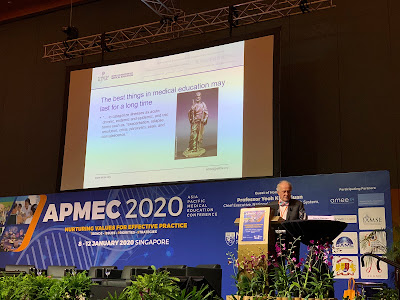可信賴專業活動的心理計量分析
可信賴專業活動(Entrustable Professional Activities,EPA)是目前全世界在勝任能力為導向的醫學教育上極為重要的發展項目。台灣各醫學專科、各醫事職類自然也不例外,近年來已有數個指標性學會陸續形成完整的EPA版本,絕大部分則在建置的過程中。縱然公版EPA在發展時會經過全國有代表性的專家審定,但真的落實到臨床場景,讓老師用於對學員進行評核時,結果仍需要經過心理計量的分析,才能確定EPA做為評估工具的信效度,並有利於後續教師及教學主管單位對這類評估的解讀跟應用。
EPA背後的教學理論決定了它作為評估工具的一些特性,EPA的信賴等級不是單純的分數,而是序列性的結果,這影響了我們該選用哪些合適的統計工具。在2020年初,我參與亞太醫學教育年會(APMEC)時,就發表了一場口頭報告,提出探索性因素分析(EFA)可用於EPA評估結果的分析上。該場口頭報告有獲得大會獎,參與評審的國際學者也表示這是我們第一次知道EPA該怎麼做心理計量分析。我也把這個分析的想法跟EPA信賴等級的大師Carrie Chen教授分享,在此後幾個國際學者討論EPA的場合,教授不時會提到:「Leon(我的英文名)的研究如何如何,值得大家參考!」。
我很確定這是個原創而有價值的研究想法,但尷尬的是,它一直不是篇研究論文,直到我提出這個想法又過了兩年多後,我才收集到足夠的個案數來完成這些分析,結果與2020年初我的假想一致。這是我們紮紮實實在台北慈院持續累積學員數、終能完成的第一篇量性研究,對團隊來說極具紀念價值。個人以為這是篇有國際水準的論文,有幸能在《醫學教育》雜誌獲得發表機會,期望未來能看到國內外投入EPA研究的學者引用這篇文獻。
以下為論文摘要:
Using Entrustable Professional Activities in Emergency Medicine Rotations for Postgraduate Year Trainees: A Psychometric Study
Tzu-Hung Liu ; Ching-Hsiu Peng ; Giou-Teng Yiang ; Yu-Long Chen
醫學教育 ; 26卷2期 (2022 / 06 / 01) , P100 - 111
Abstract
Purpose: Four entrustable professional activities (EPAs) were developed by the Taiwan Society of Emergency Medicine (TSEM) and evaluated in pilot programs for postgraduate year (PGY) trainees in their emergency medicine (EM) rotations in Taiwan in recent years. However, no validation results of the abovementioned EPA-based assessments have been reported. This study aimed to evaluate how the EPAs work in the context of postgraduate training in Taiwan. Methods: From August 2018 to February 2022, in their EM rotations, 112 PGY trainees in a teaching hospital in northern Taiwan underwent ad hoc EPA-based assessments of the four EPAs that had been performed in the EM. The entrustment levels of these EPAs were collected and examined through a series of psychometric tests. Results: Four EPAs and their 19 sub-EPAs were examined and showed excellent internal consistency (alpha: 0.870-0.936). Exploratory factor analyses revealed that all EPAs, except EPA 1, retained only one factor. In the first factor of EPA 1, the factor loadings of all eight sub-EPAs are positive. In the second factor, the factor loadings of two sub-EPAs are higher than 0.4, which indicates that the second factor measures other types of clinical competence, such as communication skills. Conclusions: The four EPAs developed by TSEM can be a valuable tool to assess clinical competencies of PGY trainees in EM rotations. However, EPA 1 measures more than one dimension of clinical competence. Low entrustment levels in this EPA-based assessment may suggest the need for training that is tailored to communication skills.
全文請至下方連結下載:




留言